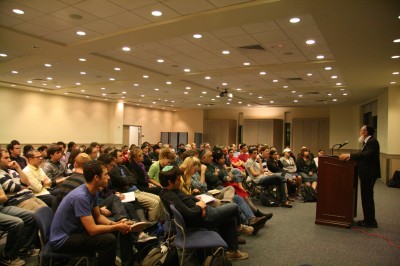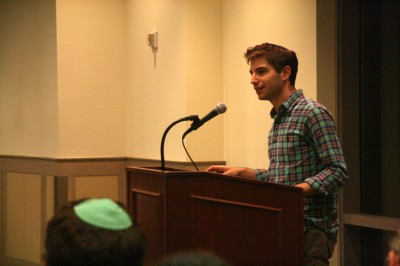
Students trickle into a cozy room. Boys walk to the farther side, and girls sit in the closer side.
A mechitza [partition] runs down the middle.
Everyone opens up his or her siddur and prepares for Kabbalat Shabbat as a female student walks up to the bima [stage] and starts the Yedid Nefesh prayer.
This scene—a trademark of partnership minyanim [prayer groups]—is becoming increasingly common on college campuses.
Ever since the Shira Chadasha minyan in Jerusalem began in 2002, independent partnership minyanim have been sprouting up around the world.
These unique prayer services attempt to function within the framework of halacha while allowing for the participation of women in the traditional service. In traditional Orthodox synagogues, women are not allowed to lead the services. The men’s section is often closest to the action.
In Shira Chadasha-style minyanim, however, women can lead Kabbalat Shabbat, the Psukei Dezimra prayers and Torah services. Inspired by rulings from Rabbi Mendel Shapiro and Rabbi Daniel Sperber, these minyanim are creating a space for egalitarian values within Orthodox Judaism.
As New York, Melbourne, and Skokie host emerging partnership minyanim, the college campus has also experienced a surge in partnership minyanim.
Mainly student-led, these minyanim originated in well-established Hillels that house similarly well-established Orthodox and Conservative communities.
One of the first college partnership minyan—Minyan Urim—was founded at Yale University by two graduate students, Michal and Elitzur Bar-Asher, who authored the Guide for the Halachic Minyan. The minyan meets every other Saturday morning for the shacharit service. According to one of the current gabbaim [synagogue assistants], Yale senior Yishai Schwartz, it attracts around 40 people. Schwartz also notes that most students who go to the Orthodox minyan on a daily basis “choose to go to Urim when it meets.”
For Yale junior and Urim gabbai Leah Sarna, it took some time to be completely comfortable with the Shira Chadasha-style minyan. When she first visited Yale as an early-admit, she went to Urim and experienced a partnership minyan for the first time.
“I grew up in a women’s tefilla sort of thing,” Sarna explained. “But that was my first time at a partnership minyan, and I really wanted to see it. But then they offered me an aliyah, and I was like, ‘No, no, no.’”
After spending a gap year in Israel, however, Sarna learned all of the relevant articles and responsas and decided that she was comfortable with the principles behind Shira Chadasha.
“It’s wonderful to feel like more of a member of the community, one that plays a greater role,” Sarna said. “Whether or not it’s a totally equal role.”
Sarna sees Urim as an outlet for committed Jewish women who want to be more active in the prayer service.
Though she attends the Orthodox minyan at Yale daily, Sarna has a hard time with the male-centricity of the service.
“I’m often there before we get a minyan. I’m standing there, the tenth person in the room, and it’s terrible. It’s really painful,” she said.
While Urim does require 10 men for a minyan, Sarna still appreciates the ability to participate more fully.
“Whenever I hear a guy screw up his kriyah [Torah reading], I’m just angry—I could do it better,” she said. “And whenever no one wants to lead shacharit, I’ll think, ‘I’ll do it!’”
At Minyan Urim, Sarna has found a space where she can at least step in for parts of the service.
Speaking of his co-gabbai, Schwartz said she is not alone. “There are women who are thoughtful, learned, and committed, and being involved in shul ritual is an important outlet,” he said. “It’s important that we create an outlet for women to be able to leyn [read the Torah portion], make brachot [blessings] on a Torah in front of a minyan in a meaningful way. The same reason that shul procedure can be inspiring for men, so too for women.”
Urim is not just a place of more opportunity for women; it also attracts students who would not otherwise attend any service. Urim tries to meet whenever the yizkor [prayers of mourning] service is said, so those who aren’t comfortable saying it in another minyan have a place to go.
The Shira Chadasha minyan at the University of Pennsylvania attracts a similarly diverse group of students.
One of the past chairs of the minyan, Penn junior Elie Peltz, appreciates the minyan’s ability to draw students from all different forms of Judaism. “There’s just something special there that drew people from all backgrounds, all affiliations and for many different reasons. And there’s something really cool about that,” Peltz said.
While the Shira Chadasha minyanim at Penn and Yale attract a large number of Orthodox students, the partnership minyan at the University of Michigan, Shalva, attracts mainly Conservative and Reform students.
According to minyan co-leader and Michigan sophomore Isaac Katz, only five or so of the 40 students that come on an average week call themselves Orthodox.
“It’s interesting there are few people who are ideologically linked to Shira Chadasha. I’m one of the few, I’d say,” Katz noted.
When Katz and his co-leader, Michigan senior Stephanie Horwitz, ask attendees why they’ve come, students tend to mention the singing, people and friendly environment.
“Maybe it does have something to do with the mechitza or the balance between tradition and egalitarianism, but that’s not what people articulate themselves,” Katz said.
Because their minyan doesn’t draw so many Orthodox students, they end up impacting the Conservative community more noticeably.
“With the Conservative minyan, it’s known that a big reason they’re struggling so much is because Shalva is so strong,” Katz said. Katz and Horwitz are now starting to talk to the Conservative minyan about the possibility of combining the two.
“We think it would definitely turn away those 5 or 6 [Orthodox students], but at the same time it would bring in people who would otherwise go to the Conservative minyan,” Horwitz explained. “It’s kind of difficult for us.”
In determining how often the Shira Chadasha minyanim meet, many consider the impact they will have on the larger Orthodox community.
One of Schwartz’s greatest concerns about Urim is maintaining a strong, unified Orthodox presence at Yale.
“It’s important to make sure that people who aren’t comfortable with Shira Chadasha-style still have a minyan,” Schwartz said.
According to Schwartz, the relationship between Urim and the traditional Orthodox minyan was a bit rocky at the start, but it has drastically improved.
“Before I got here, there definitely was a history of [conflict],” he said.
Now that the leadership of Urim largely overlaps with the leadership of the Orthodox community, much of the conflict has died down. Schwartz was simultaneously the gabbai of the Orthodox minyan and Urim. Moreover, Sarna is currently the president of the Orthodox community.
In order to create a unified community, Schwartz and Sarna make sure that when both minyanim meet, they end around the same time in order to have kiddush together. They also decided that Urim would only meet every other Shabbat, so that at least every other week, the traditional Orthodox minyan would have a healthy number of students.

“We view ourselves as part of the Orthodox community,” Schwartz said. “I’m critical of the fact that there is a tefilla group that doesn’t meet on a daily basis in a regular way. It’s not ideal, but I don’t want to impact the standard tefilla in a negative way. [We are] making sure that people of a more traditional bent are taken care of as much as maximizing participation on the other value. It’s a complex balancing act.”
After about five years of existence, the Shira Chadasha minyan at the University of Pennsylvania still strives to maintain strong relationships with the other communities in Hillel. With one of the largest university Shira Chadasha minyanim, Penn attracts about 100 students to Friday night services and about 30 students to the Shabbat afternoon mincha service.
According to Peltz, the group meets twice a month on Friday night “to allow members of the Shira Chadasha community to attend other services and be part of other communities that they also affiliate with.” They also never meet during the first week of a semester, so that the permanent Hillel minyanim can attract full attendance.
“We don’t view ourselves as a full-fledged community like the other communities in Hillel, so we don’t think it’s fair for us to meet on a weekly basis,” Peltz explained.
At Brandeis University, the Shira Chadasha minyan meets even more infrequently than at Penn, about three Friday nights during the past semester. But some of the Orthodox students still feel that the minyan takes away from the Brandeis Orthodox Organization.
According to Brandies Shira Chadasha co-leader and sophomore Viktoria Bedo, some Orthodox students feel that “to be disrupted every once in a while is bothersome.”
For Bedo though, that isn’t a pressing concern. “As much as I appreciate Jewish unity and having similar values, I don’t think that that is a reason to stop people from expressing their ideology and what they believe in,” she said. “I don’t think that it’s fair to expect that women should be giving up on greater leadership opportunities—when it’s halachically possible [in line with Jewish law] to give them these leadership opportunities—for the sake of unity.”
This past semester, the University of Maryland ran its first Shira Chadasha service. While the minyan was a success, they struggled to get full support from the traditional communities on campus.
According to Maryland sophomore Debi Goldschlag, the head of the Shira Chadasha minyan, “there was a little bit of controversy.” The Orthodox community decided not to advertise the minyan because “they thought that our minyan was taking away from their minyan,” Goldschlag explained.
But Goldschlag doesn’t think that it will make that big of an impact. “We have a huge community. We can support [the Shira Chadasha minyan] in a community like this,” she said.
For some students, the fact that partnership minyanim tend to meet less frequently than traditional minyanim is a source of concern for the future of the movement.
“On the one hand, I really like it,” Sarna said. “On the other hand, what does it mean that I’m going to daven with a minyan that meets once a week? I think it’s bad for the movement that no one has tried it already, to start a daily minyan and say, ‘Yeah we’re a fully-fledged kehillah [community].’”
Bedo, however, believes that Shira Chadasha minyanim don’t need to conform to a traditional kehillah.
“Once we don’t think in terms of a synagogue, it doesn’t really make such a difference because we can build our communities around other things as well,” she said. “People who study together also have a community.”
Another concern for students lies in the partnership minyanim’s balance of tradition with egalitarianism.
“It’s hard for me to imagine that partnership minyans are going to exist for a long time,” Sarna said. For Sarna, it’s somewhat awkward that Shira Chadasha minyanim don’t count women for a minyan and only let them lead some parts of the service. “In some ways it exacerbates the situations. We’ll let you do this, but only because we don’t even really need to do it,” she said.
Bedo feels similarly.
“I grapple with the idea that women can’t do everything. I grapple with halacha,” she said. In her opinion, the ideal minyan would be completely egalitarian, but with a mechitza separating men and women.
The Shira Chadasha movement caters to the self-exploratory nature of the college experience.
“It’s a time in people’s lives when they get to explore their identities and values and what it is that brings meaning to their lives,” Bedo said. “It’s also a time when students question their Jewish observance and what kind of Jew they want to be. So having more opportunities rather than less is great because you have a greater chance of finding something that will end up being your niche.”
Katz believes that the novelty aspect of the minyan is what makes it so attractive to Jewish students from all backgrounds. “I think that its something new and different, and I think it’s definitely a pull for students,” he said.
As the Shira Chadasha community at Penn grew stronger, Peltz realized that the minyan was enjoying increasing acceptance, not just on college campuses, but everywhere.
“In the last few years you’ve seen tiny minyanim sprout out in various communities or people are going to Shira Chadasha in Jerusalem that wouldn’t have gone before,” Peltz said. “I think that just reflects the idea that people are becoming disenchanted with this right-leaning, insular position of the Orthodox community and the lack of spirituality.”
While Peltz admits that the Shira Chadasha movement will continue to evolve, he feels strongly that it has a crucial place in Orthodox Judaism. “It might still be an alternative minyan in that it’s only a minyan and not a full shul, but I think it’s really going to make its mark on the Orthodox community.”

